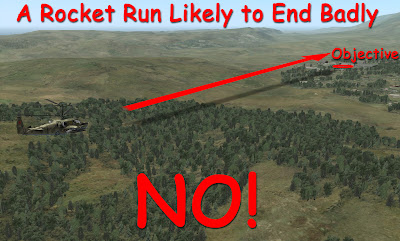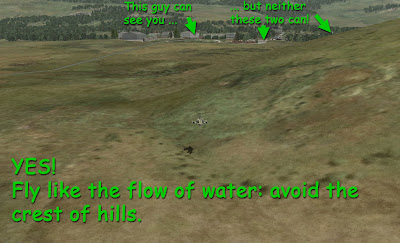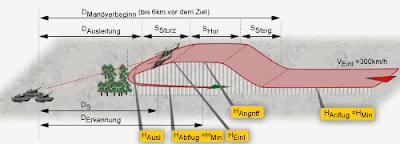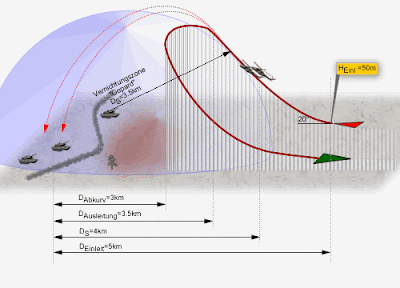This article discusses attack helicopter tactics at
the individual level. Off course, attack helicopters almost never
take-off to combat individually. At a later time, I will expand this
series to tactics to be used at the platoon level. On the meantime, the
tactical principles in this primer will help you to fly as a part of a
formation.
This series of entries are based in stuff I gathered
on the web. I condensed and adapted most of the stuff found and I
encourage you to check those original sources. The sources will be
cited at the end of each installment.
Flying to the objective
Compared
to fixed wing aircraft, the attack helicopter doesn’t have the luxury
of being able to fly very high or fast. It’s almost ironic that these
two apparent shortcomings of the attack helicopter are actually its two
advantages: being able to both fly extremely slow and at a low altitude
that allows it to evade enemy anti-air weapon systems. In addition, the
attack helicopter has a very high maneuverability that allows it to change the flight regime in small space and time spans.
Unfortunately,
the advances in radar and infrared detection technologies are always a
threat for the attack helicopter pilot. The biggest challenge for the
attack helicopter pilot is to fly towards the objective avoiding
detection. The best way to avoid detection is using terrain as cover.
If you are a virtual pilot of fixed-wing combat aircraft, it’s time for a paradigm shift.
You are used to dive majestically from the blue with your wings
pregnant of fire and the arrogant attitude of a God that entertains
himself dealing death to the poor earth-laden mortals. Those times are
gone. You are now like a hero of the ancient Greek mythology, half-god
and half-mortal. The earth where the soldier lives and dies is now your
life and death. The eternal paradoxes of tactical land combat are now
your salvation and perdition. Being pilot and soldier at the same time will require the most from your abilities and intelligence. This is your time of greatest glory.
One way to avoid detection by using terrain as cover is the so-called “nap of the earth” (NoE) flying.
In NoE flying, the pilot flies at approximately 6-7 meters above the
ground and at a speed of 90 Km/h. The vast majority of modern radar
systems cannot detect targets flying at a very low altitude. In
addition, Doppler-based radars are designed to ignore returns moving at
speeds of less than 100 Km/h in order to avoid detecting civilian
traffic. During a NoE flight, the pilot chooses a route that allows the
maximum terrain cover. The base of hills, around (not over) elevations
and behind crowded terrain is ideal for NoE flying. In mountainous
terrain, attack helicopter pilots usually fly at an altitude that is
halfway between the base and the top of the mountains.
 As exhilarating as dangerous, NoE flying requires a lot of concentration.
As exhilarating as dangerous, NoE flying requires a lot of concentration.NoE
flying is not problem-free. The slow speed and the low altitude expose
the attack helicopter to small-arms fire and un-guided rockets. An
alternative to NoE flying is
“contour-chasing” (CC) flying,
which is done at higher altitudes and speeds. CC flying is used when
the presence of enemy anti-aerial or aircraft is less likely. For a CC
flight, the pilot maintains an altitude of 12-15 meters and a speed of
150 Km/h. The pilot doesn’t fly around the hills but rather maintains a
straight course, keeping a constant altitude above the ground.
 CC flying has the advantage of higher speed at the expense of concealment
CC flying has the advantage of higher speed at the expense of concealment


10 Rules to Live By
All
forms of combat require an agile mind able to adapt to the continuously
changing challenges of the battlefield. In tactical combat, there are
never absolute truths or optimal solutions and speaking of "rules"
sounds like out of place. The "rules" discussed here are actually
guides that are valid in most situations. Take these "rules" as a
framework to think about your own solutions to the tactical challenges
you will face.
Rule #1: Never fly over the objective
...
or over any area in which you know or suspect there are enemy troops.
Remember, under your aircraft is one of the places where you cannot see
or aim your weapons.
 During un-guided rocket runs is
when most of virtual pilots make the mistake of over-flying the
objective.
During un-guided rocket runs is
when most of virtual pilots make the mistake of over-flying the
objective.

 An ideal un-guided rocket run.
An ideal un-guided rocket run.

Rule #2: Fire munitions from their maximum rangeThe farther you are from your target, the less possible it will detect and fire back at you.
 Shkval view of an enemy tank engaged with an anti-tank missile from a distance of 1.7 km. At this distance, enemy tanks can shoot you down very easily.
Shkval view of an enemy tank engaged with an anti-tank missile from a distance of 1.7 km. At this distance, enemy tanks can shoot you down very easily.
 Shkval
view of an enemy tank engaged with an anti-tank missile from a distance
of 5.3 km. At this distance, the enemy tanks will have a hard time
detecting and firing at you.
Shkval
view of an enemy tank engaged with an anti-tank missile from a distance
of 5.3 km. At this distance, the enemy tanks will have a hard time
detecting and firing at you.
Rule #3: Avoid the "Dead Man's Zone"The
crest of hills are the worst places to be hovering or flying. Remember
to use terrain to mask your helicopter. Fly around hills, not over them.
 (Click on the image for an expanded view)
(Click on the image for an expanded view)
 Rule #4: New Area=Danger Area
Rule #4: New Area=Danger AreaEvery time you enter a new area, assume that every tree is hiding an enemy anti-aircraft system.
Rule #5: There is no such thing as too much reconnaissanceTaking
advantage of your helicopter's maneuverability and powerful optic
systems, thoroughly recon any new area you are about to enter. Use
terrain to mask your position: initiate a hover from a covered
position, then slowly and progressively bob-up until you can scan all
the new area. During this bob-up, get ready to descend in case you are
detected or fired upon.
Rule # 6: Identify your targetsThe
modern battlefield is very dynamic. The position of enemy and friendly
forces can change considerably in a very short time and without notice.
Given the mobility of mechanized and armored warfare the concept of
front-line is obsolete. Identify your targets based on type of
equipment, their spatial orientation and the briefing.
Rule #7: Preserve ammunitionIt
is useless to arrive to the objective with the cannon as your only
weapon available. Focus on the mission objective. Avoid decisive
engagements with opportunity targets if doing so means risking the
completion of the mission. Also, remember that once you completed the
mission you may need ammo to fight your way back to base.
Rule #8: Know the operational situationPay
very close attention to the briefing: it contains all intelligence
available at the time of take-off. Depending the type of enemy forces
you will face, arm your helicopter with according ammo and
counter-measures. Pay close attention to the climate report, it may be
important to determine your approach to the objective area. Off all
combat aircraft, the attack helicopter is the one that operates more
close to land forces. Try to understand your mission objective in the
context of the operations of the land forces your are supporting.
Rule #9: Attack the enemy from your maximum munition range and on its flanksWhen
you attack frontally, you expose your helicopter to fire from all the
enemy line. Attacking on one flank the amount of enemy weapon systems
that can fire at you are reduced.
Rule #10: PatienceLack
of patience is a killer. When you discover enemy units at a rate higher
than the rate that you can destroy them, re-think your approach.
Source for the "10 Rules to Live By":
"Gunship Academy", by the great simulation-guides author Richard Sheffield.
The attack
This entry relies heavily in material taken from this web page. Images are used without authorization but without monetary gain. Please comment if you need them removed.
Several forms of attack are described below. You will have to choose among those based in the following considerations:
- The mission objective (area objective, groups of units, individual units, etc)
- The firepower and maneuver opportunities available to the enemy
- Terrain
- Climate
- Fire support available (number of helicopters in your flight, indirect artillery fire, etc)
- Time available to complete the mission
- Collateral damage to civilians
Attack from the horizontal flightOnce
you have determined the area where you want to attack (usually without
knowing the exact position of the targets) you climb keeping forward
speed until you reach the minimum altitude that allows you to detect
the enemy. As soon as you detect the enemy, you stop climbing and
continue the horizontal flight trying to get your selected weapon in
range. After firing the selected weapon, you break right or left and
simultaneously drop altitude so you can better use the terrain to mask
your return in the opposite direction of the attack.

The good
- You can use a great variety of weapons with this form of attack
- The time you spent above the minimum altitude is relatively small
- Can be used under unfavorable climatological conditions, like low ceiling
- You can use non-guided munitions
- (Very little piloting skills needed!)
The bad
- Short time available to detect and destroy enemy units
- There is always a chance to be detected and engaged by enemy anti-air defenses while you fly at altitudes above the minimum
Attack from the diveThis
type of attack can be used against area or individual targets. You can
use un-guided munitions or the cannon in this type of attack.
You
start flying at minimum altitude and maximum speed. Around 6 km from
the target, you climb abruptly up to an altitude such as you can
descend on a dive with your nose pointing directly to the targets. This
altitude is generally higher than the minimal altitude needed to detect
the targets. You then dive towards the targets, firing your weapons.
You then quickly break and return towards the opposite direction of the
attack.

The good
- Better chances that you will detect the targets because of the high altitude used during the approach
- Better chances of hitting targets with non-guided rockets
- (Adrenaline rush!)
The bad
- You will be flying higher during the approach and enemy anti-aircraft systems can detect and engage you
- Impossible to use under low ceiling conditions
- You need to keep an eye on airspeed and rotor rpm
Attack from the hoverYou
start from a position where your hovering helicopter is covered by
terrain and bob up or pop sideways to acquire the targets. These
movements must be conducted in a way that quickly allows you to return
to the covered position in case the enemy detects and/or engages you.
The good
- Ideal for ambushing the enemy
- If you are flying with wingmen, you can distribute targets with the other members of the flight more easily
- (Allows the virtual pilot to sip beer and eat pizza during the attack)
The bad
- Ideal for the enemy ambushing you
- Almost impossible to use non-guided rockets
- Difficult
to implement for flights of more than two helicopters (it's difficult
to find a terrain feature big enough to cover 3 or more helicopters)
- Risk of brown-out and/or impairment of optical systems performance
- (Increased
risk of beer-spattered keyboard and cheese-stuccoed monitor monitor if
the enemy is waiting for you right behind that bloody hill)
Attack from the climbThis
form of attack can be used only with rockets or bombs. This type of
attack should be considered an exception rather than a norm.
You
start a climb with horizontal speed with the nose of your helicopter at
a positive angle. At certain distance form the target, you launch your
rockets or bombs in a way that they fly in an arc. You then reverse
your flight trajectory and simultaneously dive towards the safety of
terrain cover.

The good
- This form of attack increases the range of rockets and bombs
- You keep more distance from the target
- Can be used even when climate conditions are such that visually acquiring targets is difficult
- (If you hit something of value, you will have eternal bragging rights)
The bad
- Low precision
- Munitions impact on a wide area
- Watch out for not accidently letting your rockets and bombs on friendly troops














